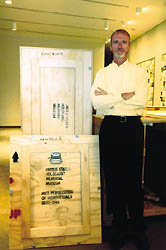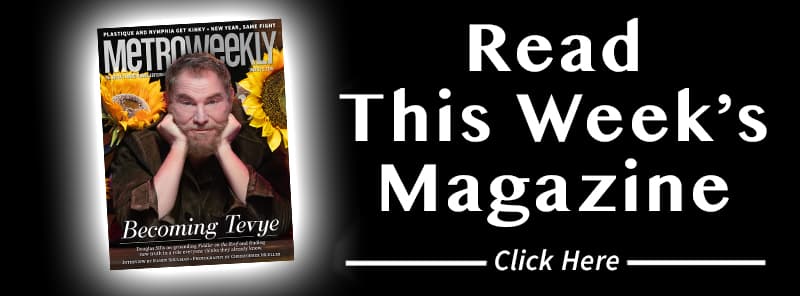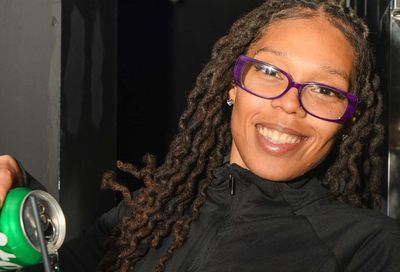History Lessons
Edward Phillips discusses Nazi Persecution of Homosexuals
Photography by Michael Wichita
 |
“I can’t believe they got it wrong. ”
Edward Phillips stands among thirteen packing crates in the U.S. Holocaust Memorial Museum’s Gonda Education Center, all stamped with the words “Nazi Persecution of Homosexuals 1930-1945. ”
He looks at a reporter, shakes his head and laughs.
“It’s supposed to read 1933. ”
Phillips is curator of the museum’s newest exhibit which chronicles the Nazi government’s attempt to eliminate homosexuality from German society — efforts that included, according to Phillips, “re-education,Â…castration, institutionalization and deportation to concentration camps. ”
Though it is estimated that over one million homosexual men were part of German society at the time, it’s believed that only 5,000 to 15,000 were sent to camps, where they were categorized with a pink triangle, now a familiar gay icon.
The exhibit is laid out on 32 elaborately designed and intricately detailed panels detailing in chronological order the German persecution of homosexuals during the years leading up to, during, and immediately following the second world war. Phillips, 50, has spent the past two years of his life researching and writing the exhibit, which will travel to other cities after it ends its Holocaust Museum run in mid-March.
“It’s been hard on my friends because this exhibit has become an obsession, ” says Phillips, who is gay. “This work became the focal point of all my conversations with people. I’m now having to relearn how to get away from it and get myself involved with the other projects at the museum. ”
The exhibit opens to the public tomorrow, Friday, November 15. But at the time of the interview, one week ago, even Phillips hadn’t seen the exhibit fully assembled.
“I’m a wreck about actually seeing the thing standing all in place, ” he admits, a wave of emotion passing through his friendly yet scholarly demeanor. “Next week will be the first time I’ve seen the whole exhibition in its final form here in the museum. I don’t know how it’s going to affect me. ”
Our guess: Profoundly.
MW: What elements came together to form the idea for the exhibit “Nazi Persecution of Homosexuals 1933-1945 “?
EDWARD PHILLIPS: Within a couple of years of the museum’s opening in 1993, the education division put together a series of pamphlets on the non-Jewish victims of the era — homosexuals, gypsies, the handicapped, non-Jewish Polish victims, and Jehovah’s Witnesses. Shortly after I got here in 1995, we began putting together a long-term exhibition plan and realized that in addition to doing core story narratives based on things that are in the permanent exhibition, the small pamphlets we’d put together would be a great opportunity to build traveling exhibitions on the untold parts of the story. We knew from the outset there was a real interest from the gay and lesbian community in knowing more about the persecution of homosexuals, so that ended up being the first choice of the institution.
MW: How do you plan an exhibit as dense as this?
PHILLIPS: The structure of many of our exhibitions here at the museum tend to start with the history. The question then becomes “How do we illustrate the history? ” because it’s the story of what happens over this period of time that we’re trying to get across. So basically the exhibition is chronological. What happens before the Nazis come to power in the Weimar era in 1918 to 1933, what happens before the war up to the outbreak in 1939, what happens during the war. And then there’s an aftermath piece to show what happens immediately after the war. The chronology shapes the story.
This exhibit is different in another way. At the museum, we tend to talk about the victims from the victims’ point of view because we can find artifacts that tell the victims’ side. With this story, however, homosexuals were persecuted prior to [WWII] under [the law Paragraph 175], which continued to remain in force in West Germany until 1969. So many of those who survived [the Holocaust] probably destroyed anything they had connected to what had happened to them because it would have linked them to being continuously viewed as criminals in the postwar period. While we actually look at the story less from the victims’ side, we try always bringing the victims’ faces up [in the exhibit]. We see the police files with their police photos. We see the documents with their names on it.
MW: How many gay men wound up in the camps?
PHILLIPS: Well, the overwhelming majority of gay men who were being targeted hid. The estimates are that there were over one million gay men in Germany during the Nazi era. A hundred thousand were arrested. You have a lot of arrests, but we think the arrests were probably to gain information to draw other names. Only half of the men who were arrested were actually convicted. Of those, a very small percentage ended up in the concentration camps — estimates are about fifteen thousand men. And that’s kind of an outside number.
MW: What about lesbians?
PHILLIPS: The persecution itself was very much focused on German men — that’s a point that has to be emphasized. It’s not about lesbians, it’s always about German men. In the Nazi viewpoint, men were clearly the center of society. It was a male-dominated society — men had all the ruling power, all the authority. Women were viewed very much in an auxiliary fashion; their primary role in society was to have babies. Gay men were blamed as taking away their reproductive capacity by not being involved in heterosexual relations and therefore fathering children. The belief was that lesbians could still always have babies. It’s an incredibly misogynistic outlook that the Nazi regime very much believed women would revert to their “natural ” role, mother and wife.
Part of the persecution of males was actually sort of a conflict with the Nazis in that they believed that some men were incorrigibly homosexual, that it was in their nature. But the majority of homosexuals, the Nazis thought, had learned it or had chosen it and could be reeducated to retake their roles as fathers, as masculine men. So much of the effort in both prison and concentration camps was supposedly reeducation to make them straight men to fulfill their societal duties.
MW: Clearly, those men who were the most effeminate or flamboyant were the biggest threat to the Nazi male ideal.
PHILLIPS: Correct. The Nazis feared homosexuality was a degeneracy that was feminizing society, weakening the whole social fabric. So the effort was to either reeducate them into being reproductive or to get them out of the way.
MW: How did so many gay men avoid persecution?
PHILLIPS: A lot of individual [gay] men simply focused on their careers — it was still a society that was functioning. They either became celibate or went completely closeted or underground. There’s evidence that some married lesbian women — protective marriages they called it. I have a wonderful photograph in the exhibition of a gay couple and behind one man is the woman he married but her image is blurred. It shows the artificiality of the situation. But many people simply just closeted themselves and survived.
MW: Is there danger in saying that such extreme persecution could never happen here?
PHILLIPS: Part of our mission here at the museum is to point out what has happened in the past in hopes of keeping people aware of what could happen. Much of our focus is about bystanders — people who saw it going on but did nothing. And that’s one of the great lessons we want to be able to teach here at the museum: bystanders have roles. It’s really up to the bystanders to step forward.
What was particularly awful to me is it was a state decision to go after several groups and target them for state persecution. It is the government that identified a group and then basically gave free reign to the society to do what they wished to persecute these people. So the government opened the door to allowing people to denounce their neighbors if they even suspected them of having a male visitor and the lights go out. Questions are raised and they can turn that over to the police and the police can act on it.
MW: How do you respond to the Holocaust deniers, people who claim that the Holocaust never occurred?
PHILLIPS: That’s just nuts. It’s outrageous to me because we have so much documentation in our permanent exhibition, in our archives, in our photo collection, that completely documents the truth of this event. You cannot deny history, especially when history is so well-documented.
And that’s really so much of what makes this institution so powerful: we rest on the strength and accuracy and total truth of what it is that we present. If we have any questions, if we cannot document any aspect of what we think may be the history, then we don’t present that history until we can document it. The “Persecution of Homosexuals ” exhibition itself reproduces some two hundred fifty images and documents from police files and other sources from across Germany that show these individuals went through the events that I’m telling about on the text panels. So the real effort has been for the last two years to put together the most accurate presentation of this piece of history from 1933 to 1945.
MW: Let’s talk about the pink triangle. There are those in our community that feel it’s an inappropriate symbol for modern gays.
PHILLIPS: When I do my public speaking, I wear a pink triangle medallion, but I wear it as a memorial to those who were persecuted. I don’t wear it as a symbol of being an out gay man, because I see it as a symbol of oppression. The rainbow is festive and happy — that should be the one we keep using. I don’t see the pink triangle as a symbol of liberation because it was put on people who were incarcerated. I understand the feelings about negatives into positives, but the history is so powerful and painful behind the pink triangle that it’s hard for me to turn it into a positive symbol.
MW: You have spent two years of your life on this project. I’m sure from an academic standpoint, it’s extremely rewarding research. But I’m curious what kind of emotional toll research such as this takes on a person?
PHILLIPS: Well, it has been a hard two years. I’m a historian by training, so I can distance myself from the material as I’m working through it. But as a gay man, it really became a challenge, because you can’t help but be drawn into the personal stories without thinking that “If I were in Berlin in the 1930s, this could be me. ”
“Nazi Persecution of Homosexuals 1933-1945 ” is on display in the Gonda Education Center of the United States Holocaust Memorial Museum, 100 Raoul Wallenberg Place SW, from Friday, November 15 through Sunday, March 16. No passes are required for this exhibit. The museum is open from 10 a.m. to 5:30 p.m. daily. For more information, call 202-488-0400 or visit www.ushmm.org.
Support Metro Weekly’s Journalism
These are challenging times for news organizations. And yet it’s crucial we stay active and provide vital resources and information to both our local readers and the world. So won’t you please take a moment and consider supporting Metro Weekly with a membership? For as little as $5 a month, you can help ensure Metro Weekly magazine and MetroWeekly.com remain free, viable resources as we provide the best, most diverse, culturally-resonant LGBTQ coverage in both the D.C. region and around the world. Memberships come with exclusive perks and discounts, your own personal digital delivery of each week’s magazine (and an archive), access to our Member's Lounge when it launches this fall, and exclusive members-only items like Metro Weekly Membership Mugs and Tote Bags! Check out all our membership levels here and please join us today!
























